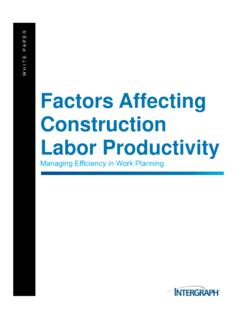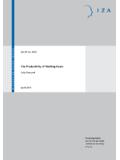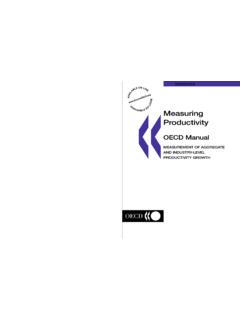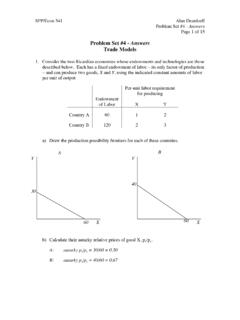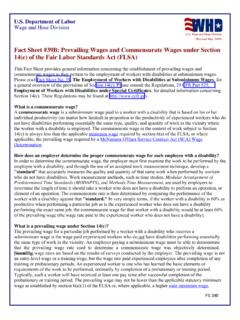Transcription of Metrics and tools for measuring construction productivity ...
1 NIST Special Publication 1101 Office of Applied EconomicsBuilding and Fire Research Laboratory Gaithersburg, Maryland 20899 Department of CommerceNational Institute of Standards and Technology Metrics and tools for measuring construction productivity : Technical and Empirical Considerations Allison L. Huang, Robert E. Chapman, and David T. Butry NIST Special Publication 1101 Department of CommerceNational Institute of Standards and Technology Office of Applied EconomicsBuilding and Fire Research Laboratory Gaithersburg, Maryland 20899 Metrics and tools for measuring construction productivity : Technical and Empirical Considerations Allison L. Huang, Robert E. Chapman, and David T. Butry Sponsored by: National Institute of Standards and Technology Building and Fire Research Laboratory September 2009 DEPARTMENT OF COMMERCE Dr. Gary Locke, Secretary NATIONAL INSTITUTE OF STANDARDS AND TECHNOLOGY Dr. Patrick D. Gallagher, Deputy Director Abstract Although the construction industry is a major component of the economy, it has experienced a perceived prolonged period of decline in productivity .
2 Due to the critical lack of measurement methods, however, the magnitude of the productivity problem in the construction industry is largely unknown. The measurement problem is exacerbated by the fact that the construction industry is composed of four sectors that differ significantly in the outputs produced, firm size, and use of technology. The four sectors, which taken together define the construction industry, are residential, commercial/institutional, industrial, and infrastructure. This report describes efforts underway that focus on the measurement of construction productivity at three levels task, project, and industry and how such measurements can be developed. This report analyzes the measurement challenges associated with the development of meaningful measures of construction productivity at the task, project, and industry levels and establishes a framework for addressing those challenges. Specifically, this report identifies the Metrics , tools , and data needed to move forward in collaboration with key construction industry stakeholders.
3 Once produced, these Metrics , tools and data will help construction industry stakeholders make more cost-effective investments in productivity enhancing technologies and improved life-cycle construction processes; they will also provide stakeholders with new measurement and evaluation capabilities. Finally, this report lays the foundation for future research and for establishing key industry collaborations that will enable more meaningful measures of construction productivity to be produced at the task, project, and industry levels. Keywords Building economics; construction ; economic analysis; information technology; labor productivity ; Metrics ; performance measurement; productivity iii iv Preface This study was conducted by the Office of Applied Economics in the Building and Fire Research Laboratory at the National Institute of Standards and Technology. This report analyzes the measurement challenges associated with the development of meaningful measures of construction productivity at the task, project, and industry levels and establishes a framework for addressing those challenges.
4 The intended audience is the National Institute of Standards and Technology, as well as, other government agencies that compile and publish construction -related statistics, private sector organizations concerned about the perceived decline in construction productivity , and standards development organizations that produce standards used by the construction industry. Disclaimer Certain trade names and company products are mentioned in the text in order to adequately specify the technical procedures and equipment used. In no case does such identification imply recommendation or endorsement by the National Institute of Standards and Technology, nor does it imply that the products are necessarily the best available for the purpose. Disclaimer Regarding Non- Metrics Units The policy of the National Institute of Standards and Technology is to use metric units in all of its published materials. Because this report is intended for the construction industry that uses customary units, it is more practical and less confusing to use customary units rather than metric units.
5 Measurement values in this report are therefore stated in customary units first, followed by the corresponding values in metric units within parentheses. Cover Photograph Credits DigitalVision construction in Action clip gallery image used in compliance with DigitalVision s royalty free digital stock photography use policy. v vi Acknowledgements The authors wish to thank all those who contributed so many excellent ideas and suggestions for this report. They include Mr. Mark E. Palmer, Leader of the Computer-Integrated Building Processes Group in the Building and Fire Research Laboratory (BFRL) at the National Institute of Standards and Technology (NIST), for his technical guidance, suggestions, and support. Special appreciation is extended to Mr. Douglas Thomas of BFRL s Office of Applied Economics (OAE) for his thorough review and many insights and to Ms. Carmen Pardo for her assistance in preparing the manuscript for review and publication. Special appreciation is also extended to Professor Paul M.
6 Teicholz, Professor Emeritus in Civil and Environmental Engineering at Stanford University, for the many stimulating exchanges that have truly improved this report. The report has also benefited from the review and technical comments provided by Dr. Nicos S. Martys and Ms. Geraldine Cheok of BFRL s Materials and construction Research Division. vii viii Table of Contents Abstract .. iii Preface .. v Acknowledgements .. vii Acronyms and Abbreviations .. xiii Acronyms and Abbreviations .. xiii 1 Introduction .. 1 Background .. 1 Purpose .. 3 Scope and Approach .. 3 2 construction : An Engine for Economic Growth .. 7 Value of construction Put in Place .. 7 Overview of the construction Industry Supply Chain .. 11 Research and Innovation in the construction Industry .. 18 3 productivity and Competitiveness: A Survey of the Literature .. 21 Three Dimensions of construction productivity : Task, Project, and Industry .. 21 Factors Affecting construction productivity .
7 22 Skilled Labor 22 Technology Utilization .. 27 Offsite Fabrication and Modularization .. 29 Use of Industry Best Practices .. 30 Task Level productivity Metrics .. 31 Task Level productivity Measures .. 31 Task Level productivity Estimates .. 33 Project Level productivity Metrics .. 35 Project Level productivity Measures .. 35 Project Level productivity Estimates .. 36 Industry Level productivity Metrics .. 38 Industry Level productivity Measures .. 38 Industry Level productivity Estimates .. 39 Reconciling Industry-Level productivity Estimates with Task-Level productivity Estimates .. 41 Quality of Industry-Level productivity Estimates .. 41 Appropriateness of Output Measure .. 41 Lack of Output Deflators .. 42 Quality of Input Measures .. 44 Changes in Output Mix .. 44 Task-Level productivity Does Not Completely Reflect Industry-Level productivity .. 47 Different Definitions of productivity Measures and Different Definitions of the construction Industry.
8 48 ix Conclusions and Observations .. 49 4 Challenges and Opportunities in construction productivity Measurement Using National Statistics .. 51 Discussion of the Teicholz Diagram .. 51 Approaches for measuring construction productivity .. 54 Focus on Building Types, Gross Output .. 55 Focus on Building Types, Value Added .. 57 Focus on Infrastructure Type, Value Added .. 59 Focus on Specialty Trades .. 59 Focus on Residential Building construction .. 60 5 Summary and Recommendations for Future Research .. 63 Summary .. 63 Recommendations for Future Research .. 63 Standard Practice for measuring Task-Level and Project-Level productivity .. 63 Database of Project-Level productivity Measures for Capital Facilities .. 64 Industry-Level productivity Metrics .. 65 References .. 67 Appendix A Metrics of productivity .. 75 Industry-Level productivity Measures .. 75 Labor productivity .. 75 Multifactor 76 Value-Added Function, Choice of Output Measure, and the Role of Intermediate Inputs.
9 78 Output Measures .. 80 Gross Output versus Value Added .. 80 Price Deflators .. 81 Labor 83 Hours (Production Workers) .. 83 Conversion from Hours Paid to Hours Worked .. 83 Hours (Nonproduction Workers) .. 84 Self-Employment .. 85 Labor Costs .. 86 Labor Quality .. 86 Capital 88 Intermediate Inputs .. 90 Aggregation Methods .. 92 Overview of BLS productivity Program .. 93 Classification Issues .. 93 Appendix B productivity and Competitiveness: An Annotated Bibliography .. 97 construction productivity and Related Issues .. 97 construction Data .. 108 x productivity Data and Measurement .. 109 Appendix C Sources of construction Data Related to productivity and Their 117 Sources of construction Data Related to productivity .. 117 Classification Systems, Variables, and Coverage .. 125 Appendix D Glossary of Selected Terms .. 161 List of Figures Figure 2008 Breakdown of $1072 Billion construction Market .. 11 Figure Impacts of construction Industry Supply Chain in 2008.
10 12 Figure Value of construction Work and Value of Business done by Size of Figure Annual Average Number of Employed Persons in the construction Industry by Age Groups, 2000 through 2008 .. 23 Figure Percentages of Employed Persons in the construction Industry by Age Groups, 2008 through 2008 .. 24 Figure Percentage of Private construction Workers with Union Membership and Percentage of Private construction Workers under Collective Bargaining Agreement, 1973 through 2008 .. 25 Figure construction Industry Production Worker Average Weekly Hourly Wage as a Percentage of Total Private Sector Production Worker Average Hourly Wage .. 26 Figure Ratio of Total Installed Cost to Work Hour (Normalized to the Value of Year 37 Figure Changes in construction Output Mix (1964-2007) .. 46 Figure Dollar Amount Single-Family House construction as a percentage of Residential, Commercial, Industrial, and Institutional construction (1964-2002) .. 47 Figure construction Labor productivity and Non-Farm Business Labor productivity Comparison.)










